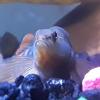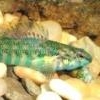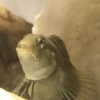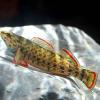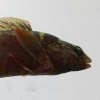Darter tank questions
#1

Posted 08 April 2021 - 09:29 PM
#2

Posted 08 April 2021 - 10:01 PM
Have you checked water temp? I think darters tend to need more oxygen than some other natives to thrive.
#3

Posted 08 April 2021 - 10:34 PM
Have you checked water temp? I think darters tend to need more oxygen than some other natives to thrive.
The temperature is probably around 70-72, but the powerhead I have in the tank has an air tube attached that pumps in oxygen with the current. I believe the tank is pretty well aerated because of that
Edited by pitt20, 08 April 2021 - 10:35 PM.
#4

Posted 08 April 2021 - 11:34 PM
Keep in mind powerheads can really heat up a aquarium to lethal levels for natives. (especially on aquariums this small) Also if you're worried about everyone getting adequately fed you can use a turkey baster to target feed them.The temperature is probably around 70-72, but the powerhead
#5

Posted 09 April 2021 - 12:03 AM
Keep in mind powerheads can really heat up a aquarium to lethal levels for natives. (especially on aquariums this small) Also if you're worried about everyone getting adequately fed you can use a turkey baster to target feed them.
I used a digital thermometer to test the water temperature, and it was 71.1 degrees. Would you recommend taking the powerhead out, or is that ok? The darters are all colored up and seem active. The two that haven’t eaten in the past two days appear interested in food and get excited when I put it in the water, but the dominant redline chases them when they try to eat it.
Edited by pitt20, 09 April 2021 - 12:07 AM.
#6

Posted 09 April 2021 - 09:49 AM
I used a digital thermometer to test the water temperature, and it was 71.1 degrees. Would you recommend taking the powerhead out, or is that ok? The darters are all colored up and seem active. The two that haven’t eaten in the past two days appear interested in food and get excited when I put it in the water, but the dominant redline chases them when they try to eat it.
This is interesting to me. This might sound crazy, but adding a couple more darters might spread the aggression. I have about 15 darters with 12 minnows in 20 gallons of water - this is a bit extreme but they were mostly very young when I got them and they're going into a bigger tank soon.
#7

Posted 09 April 2021 - 10:58 AM
#8

Posted 09 April 2021 - 11:14 AM
This is interesting to me. This might sound crazy, but adding a couple more darters might spread the aggression. I have about 15 darters with 12 minnows in 20 gallons of water - this is a bit extreme but they were mostly very young when I got them and they're going into a bigger tank soon.
Interesting, I could try that. I just rearranged the tank to provide more hiding places so we’ll see what happens. If I were to add more, I have turquoise, swamp, and tessellated darters in my area. Would any of those work in this setup?
Sent from my iPhone using Tapatalk
#9

Posted 09 April 2021 - 11:15 AM
You might be over feeding them with so much bloodworms. That much food can easily pollute a 10 gal tank. A 20 gal long tank with lots of hiding places will alleviate some stress caused by the bully. Add frozen mysis to vary their diet.
Thank you, I’ll cut back. I have some mysis in the freezer so I’ll try half a block of that next time I feed them.
Sent from my iPhone using Tapatalk
#10

Posted 09 April 2021 - 02:54 PM
That depends, if you can keep your abode below or at 71-72 all summer long then your aquarium shouldn't reach those potential fatal temps (76-77+) but if you can't I'd just recommend using a 20-40 gallon air pump & if you want some current there's a old nanfa article on how you can modify a hob filter to produce current. (if you want to check the article out just type in riffle aquarium nanfa it should be the first thing that pops up)I used a digital thermometer to test the water temperature, and it was 71.1 degrees. Would you recommend taking the powerhead out, or is that ok? The darters are all colored up and seem active. The two that haven’t eaten in the past two days appear interested in food and get excited when I put it in the water, but the dominant redline chases them when they try to eat it.
#11

Posted 09 April 2021 - 02:59 PM
That depends, if you can keep your abode below or at 71-72 all summer long then your aquarium shouldn't reach those potential fatal temps (76-77+) but if you can't I'd just recommend using a 20-40 gallon air pump & if you want some current there's a old nanfa article on how you can modify a hob filter to produce current. (if you want to check the article out just type in riffle aquarium nanfa it should be the first thing that pops up)
I’ll have the AC running all summer so it should stay in that range. I’ll keep monitoring it with the thermometer to make sure, and switch over to the air pump/filter method if need be. Thank you!
Sent from my iPhone using Tapatalk
#12

Posted 09 April 2021 - 03:06 PM
Interesting, I could try that. I just rearranged the tank to provide more hiding places so we’ll see what happens. If I were to add more, I have turquoise, swamp, and tessellated darters in my area. Would any of those work in this setup?
Sent from my iPhone using Tapatalk
I keep a tessallated dater with rainbow, greenside, and fantail darters. I guess it would do fine in your setup. Tessallated darters are kind of plain looking, but I like mine because of the huge dorsal fin - it provides a contrast to the other darters; and I think it moves a little differently. That's a personal preference of course; I'm usually more interested in behavioral and movement aspects of fish as opposed to ornamental qualities. My favorite overall are the fantails.
#13

Posted 15 July 2021 - 11:24 AM
Darters don't necessarily need a river-tank type environment with pòwer head flow. They DO need more oxygenated water, but they can live without the current. The power head heats up the water for sure, and in a 10 gallon tank, that'll heat it up pretty quickly. These aren't tropical fish, so cold water won't hurt them. They prefer it. I keep rainbow, banded, Johnny and fantail darters in a 30 gallon tank without a power head, and only aeration, and very successfully.
Lastly, these are finicky fish. Took me almost 4 days to get my rainbows accustomed to bloodworms.
#14

Posted 15 July 2021 - 02:18 PM
Live blackworms make for a nice treat now and then if you can get them.
I also highly recommend the turkey baster method. After a short while of feeding them that way, they will all flock to it to get food no matter what is in there. That's how I was able to get my darters to transition to frozen food (and some dried foods). Outside of the turkey baster, they'd ignore frozen bloodworms or mysis (at first), but when i used the turkey baster that they associated with live blackworms, they'd eat anything that came out of it. Plus, all of them will be there to feed, and if you do it away from the "bully's" territory, they will all feed with little nipping at each other.
Also, if you have faster fish like minnows, dace, and shiners in the tank, the turkey baster targeting ensures that your darters won't starve. Those speedy fish eat most of the food before it can get to the darters.
Outside of the turkey baster, my tessellated and greenside darters eat almost everything, My rainbow darters eat frozen and live foods. My fantails only eat live foods, although I saw one of them eat and not spit out earthworm flakes last night for the first time. I've had all but the tessellated in my tank for 6 months to a year. The tessellated are only a month long in the tank.
Kevin Wilson
#15

Posted 16 July 2021 - 05:53 AM
FWIW, I kept Redlines 76F+ all year long, with an additional powerhead for water movement. Breeding behavior and courtship was observed. Not sure where the 'fatal' talk is coming from.
#16

Posted 17 July 2021 - 05:00 PM
FWIW, I kept Redlines 76F+ all year long, with an additional powerhead for water movement. Breeding behavior and courtship was observed. Not sure where the 'fatal' talk is coming from.
Very interested to hear about your experience keeping redlines. Did they spawn without temperature conditioning? I would like to try and replicate what you did with my maculatus-complex spp
I agree with you on the "fatal temps", there are only a select few darters that I would say could not handle temps of 76-78 (even with lots of aeration), with all those being species restricted to higher elevations like greenfin and swannanoa darters or spring restricted species. I have personally found redband darters in the wild in water that is probably 80+ during the day (in July) in the unshaded areas, I imagine in August it gets even warmer.
#17

Posted 18 July 2021 - 09:55 AM
1 user(s) are reading this topic
0 members, 1 guests, 0 anonymous users


